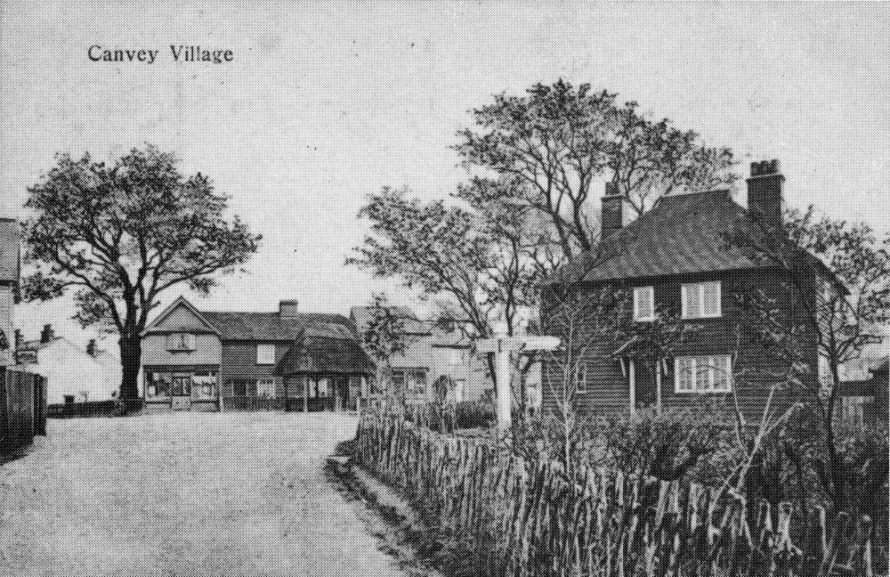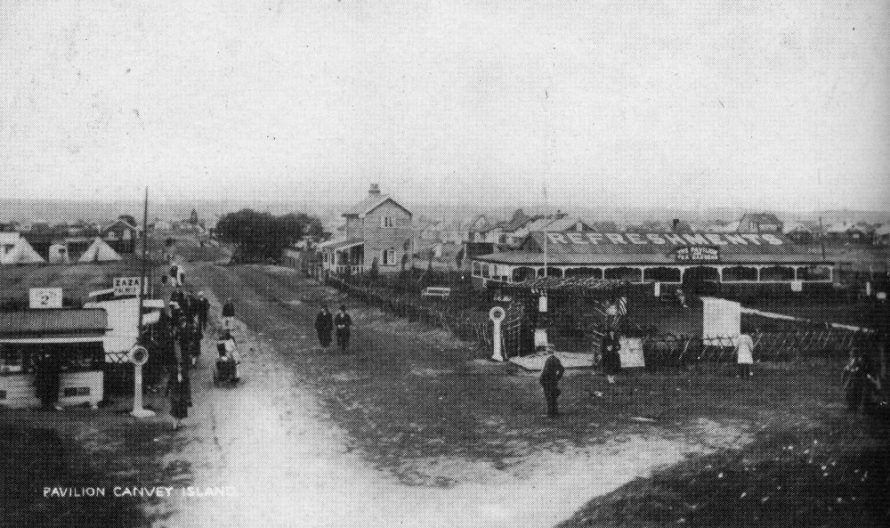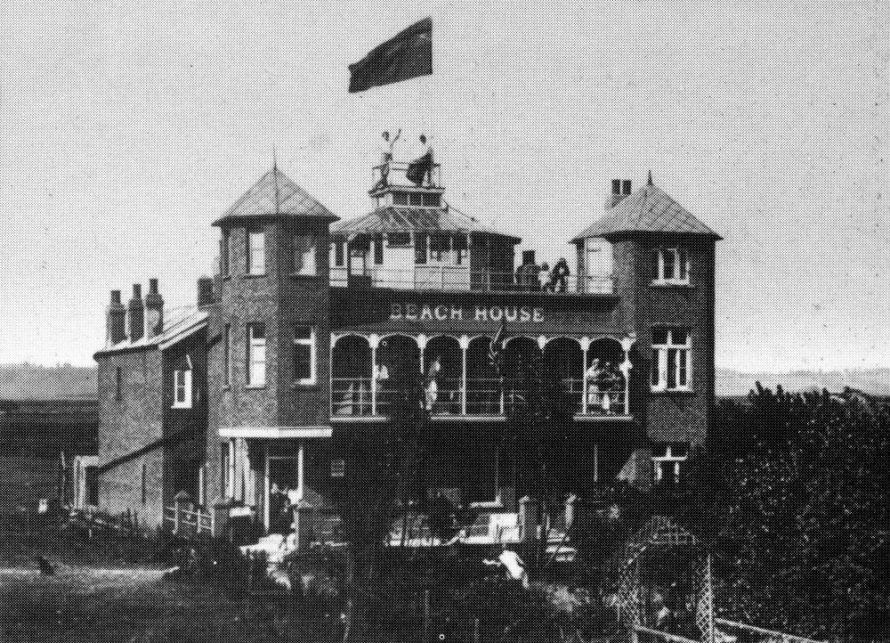Fred McCave has written many articles about Canvey Island. The one I am writing about here was published in the Essex Countryside in December 1977 and gives a good illustration of life on Canvey in the 1920’s. He starts off just after the end of the war:
- When the guns ceased to fire for the last time in 1918 it was found that Canvey Island had been very little altered by the great conflict. True, soldiers had been stationed there and an anti-aircraft gun -known as Canvey’s “baby” had opened up on Zeppelins and Gotha bombers, but otherwise hostilities had made little change. It was still a great, green-walled park, bounded by 15 miles of sea wall which were to remain intact until the East Coast flood disaster of 1953. The population was largely agricultural while the main focus of entertainment was Cox’s Hotel with its dance hall.
He goes on to talk about the ferry and the stepping stones and the problems that arose because of the difficulty getting on the Island especially in an emergency, the sort of help we take for granted today:
- The difficulties experienced by this poor way of reaching the island are illustrated by a fire drama in a large field containing four bungalows. One caught alight and the mainland fire force was alerted. Unluckily, it was high tide when they reached Benfleet and they had to wait till it went down before attempting to cross. By the time they were able to reach the scene all four properties had been reduced to ashes.
With no mains water any water supply was ‘jealously hoarded’ with drastic actions being taken when the tennis courts cracked:

The approach to Canvey Village showing the pump in the 1920’s
- Main water had to come from the thatched- roofed pump at the village, in the centre of Haven Road or literally from the roofs of bungalows where it drained into galvanised steel tanks and was jealously hoarded for the hot, dry summers that seemed to abound then. One such was in 1921 when the dykes dried up and the cattle came in from the fields lowing round the pump, like a scene from an old western film. Grass tennis courts cracked and the gaps were stuffed with wet paper.
He describes crowds of people pouring down from Fenchurch Street:
- Bed and breakfast was offered very cheaply, longer lets were available, or one could pitch a tent (very often Army surplus) for nothing. Land was readily available and in those halcyon days before planning permission a rich variety of what post second war experts were pleased to describe as “non-traditional structures” went up. The better ones were mainly timber but old railway carriages, trams and buses were also pressed into use. The substantial ones had roofs of thin asbestos tiles but others still relied on corrugated iron – as one explained “It takes such a long time to rust through m’dear.” Octagonal ex-Forces billets were also put up, perhaps, in some way rivalling the two 17th century Dutch cottages which at that time were both lived in.
In the days before EU directives:
- They were great days in the summer with the shops keeping open until nearly midnight, and if you knew the way round to the back entrance you could still be served into the early hours of the morning. Visitors used to stroll round in the evenings, playing banjos and accordions, singing and laughing. In the hot, airless nights people went midnight bathing.
With tea parties and concerts there always seems to have been lots to amuse the crowds:

The Pavilion, bottom May Avenue, used to hold tea dances
- Andrew’s Amusement Arcade, opposite the Pavilion, offered all sorts of thrills, a merry-go-round, helter skelter, coconut shy, rifle range with real Winchester repeaters, and much more. Rivalling this, at the end of Seaview Road was Sutherland’s Silver Fun City, offering much the same. Whereas Andrews was presided over by Ted Andrews, Sutherland’s had a taste of a woman’s authority, with the owner, Mrs. Sutherland, keeping a more than watchful eye on things. She was reputed to carry a stout cosh, and so had no problems with vandalism. When the Canvey Island Urban Council bought her site she retired to Norfolk to an estate where the deeds empowered her to own as much land as could be gained by throwing a hunting spear from the water’s edge.
- Further along the front was The Beach House a crenellated boarding house, with room for tents in the garden, plus grass lawn tennis courts. Opposite, on the seaward side of the wall was one of the several jetties from which motor boats plied their trade taking holiday- makers to Southend or even to far off All Hallows on the Kent side of the estuary.
With the large increase in the population a new school was needed to replace the Church of England School in the village. The new school later rebuilt and called William Read School has its 85th anniversary this October:
During the 20’s Southend Waterworks had introduce a water supply from their boreholes, but it was a while before everyone had the supply:
- Until they did people bought supplies from authorised shopkeepers at a penny a can. One did not always appreciate the benefits of semi-rural life staggering down an unmade, winter flooded road in the early darkness! For those who were unable to avail themselves of this benefit, they were advised that the minimum capacity of their rain water storage tanks should be 400 gallons. This was also to be insisted on when placing an order for a new bungalow. At that time only 129 properties got water directly.
In 1926 Canvey Island became an Urban District with its new Urban Council holding its first meeting on the 7th April of that year.

Beach House with its tennis courts and camping facilities was ever popular with holiday makers
One last story Fred told was about transport on the Island at the time, what a lovely way to end:
- Transport was becoming more readily available as a commuter population began steadily to build up and “cheap rail fares to and from London” was a catch phrase. One- man buses, where the driver took the fares and drove, were in operation, as were Hackney carriages and even horses and traps. They used to wait on the Canvey side of the creek for their customers either to arrive by ferry boat or come across the stepping stones. The drivers used to stretch themselves along the palings by the duck pond at Waterside Farm (now Waterside Sports Complex). One day the inevitable happened, the fence sagged, broke loose and threw them all into the water.




No Comments
Add a comment about this page